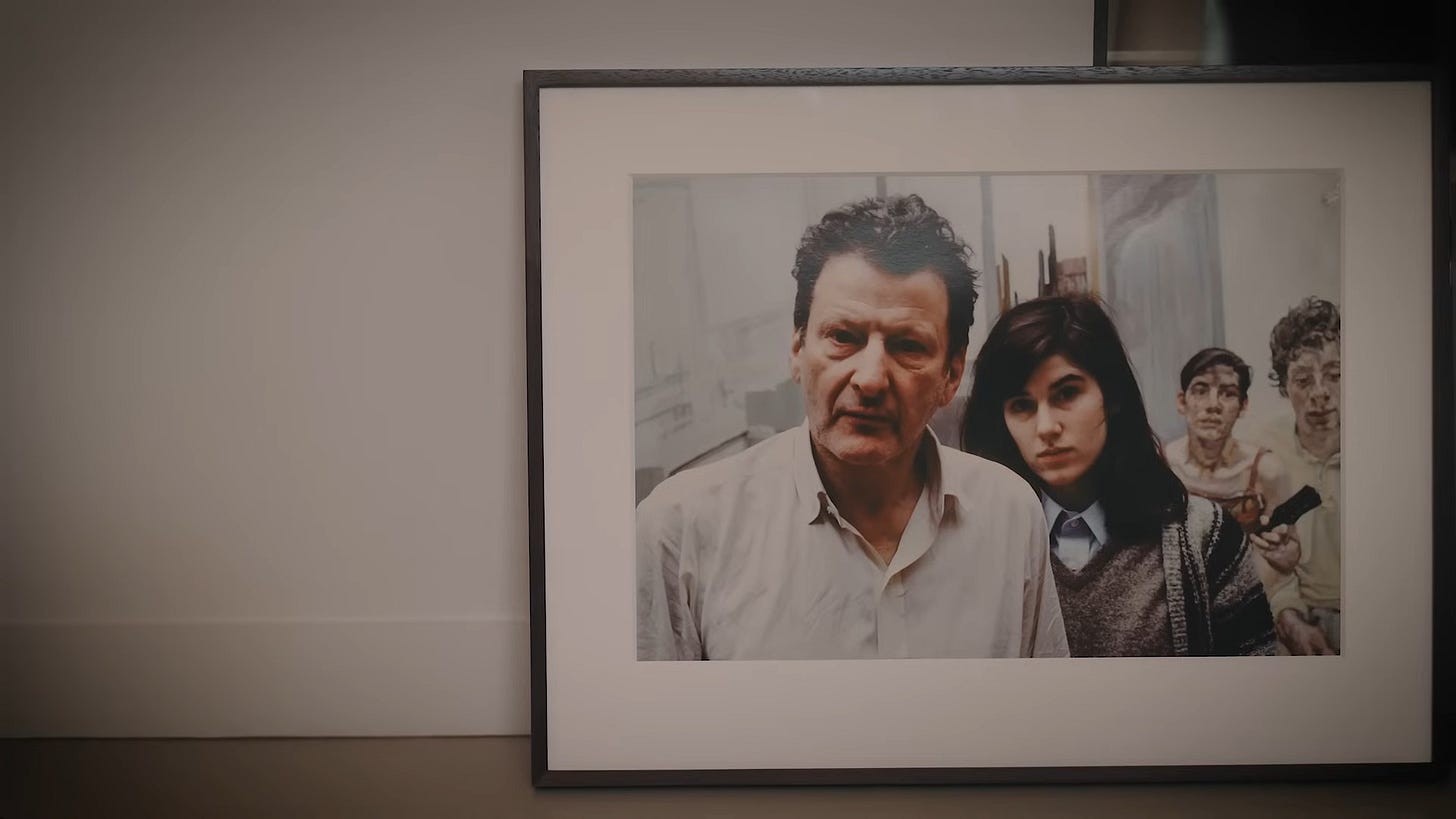(Bella) Freud's Self-Analysis
Or, the example as the thing itself
Some time towards the end of 2024, I was seated in the office of an acquaintance of mine, who, for the sake of this anecdote, was (and is), an academic teaching at a Japanese university. As I sat there, listening to them talk, I was simultaneously trying hard to avoid direct eye contact with the imposing framed portrait of Jacques Lacan that hung just behind them.
Our conversation drifted toward the perennial difficulties of acclimatising students - and Japanese students in particular1 - to what we might call the ‘therapeutic encounter.’ My colleague’s department, which offered graduate degrees in psychopathology, with an emphasis on psychoanalysis, primarily attracted students from clinical psychology or psychiatry backgrounds - fields that would ordinarily maintain some distance from the discursive nature of ‘talking therapy.’
Pedagogically speaking, the method the department had adopted was a pragmatic one, essentially screening whole episodes of Vice’s The Therapist, and subsequently dissecting each ‘session’ as if it were a clinical text. The argument here was simple: though the show was not psychoanalysis, its form - the dyad, the focus on speech, the staged interventions, etc. - offered a good-enough approximation to serve as an example.
This anecdote, I think, illustrates a broader paradox in the teaching of psychoanalysis, namely, how does one teach what is fundamentally abstracted through representation? In the French tradition - to which my colleague belonged - this paradox is often expressed in terms of ‘transmission,’2 and exemplified by the phrase: “psychoanalysis is transmitted and not taught.”3 This phrase occurs throughout the psychoanalytic literature in France, and especially so, since the term ‘transmission’ is itself so over-determined. In Freud’s German - as Übertragung - it incorporates the meanings (alongside transmission) of ‘translation,’ ‘conversion,’ ‘application,’ and, crucially, transference.
The question of whether psychoanalysis can even be taught preoccupied (and continues to preoccupy) a large cross-section of analysts working in France. One of these analysts, Jean Laplanche, was similarly preoccupied, though I would argue that this dimension of his work is seldom spoken of.
Laplanche’s seminar at the UER des Sciences Humaines Cliniques at Université Paris VII,4 subsequently published as his Problématiques, is demonstrative of this view that psychoanalysis, even in its most mediated forms, remains transmissible - to both analysts, and ‘non’-analysts alike - by virtue of our shared relationship to the unconscious:
Analysis is localised in a place and a time - the place of the cure and the time of its duration - though even this limitation is already questionable: who would argue that analysis did not also extend into self-analysis, and, I would add, that it is already preceded by self-analysis? But, more broadly, what would analysis be if it did not refer to something accessible in everyone, something that precisely exceeds the analytic cure?5
and further -
…you all, we all 'have been, are, or are about to be' in analysis, even if, in your life, you will never find yourself lying on a couch. To renounce the teaching of analysis to non-analysts, to you who are not necessarily analysts, is to give up inventing or endlessly reinventing a mode of teaching which is precisely accessible to the inspiration of the analyst, permeable to the unconscious.6
Laplanche’s point - which I’ll expand on in a future piece of writing - is that the kernel of psychoanalysis (the unconscious) is already there, ‘within’ each of us. Learning psychoanalysis, then, hinges on recognising that interior relation as much as locating its action in an external example - whether The Therapist or, as I’ll argue, Bella Freud’s Fashion Neurosis.
Bella Freud’s Fashion Neurosis
A week after my encounter with Lacan’s portrait, I was watching the first episode of Bella Freud’s podcast, Fashion Neurosis (above). Perhaps because of this earlier conversation with my colleague, these two things came together, reaching a certain synthesis of thought regarding the place of self-analysis in the teaching of psychoanalytic theory, and Fashion Neurosis, despite its apparent superficiality, inadvertently presents us a perfect example of psychoanalysis.
Fashion Neurosis with Bella Freud (to give it it’s full name), is, by all accounts, another podcast within the ‘celebrity-talks-to-another-celebrity’ genre, and operates within a knowing satire of the psychoanalytic heritage Bella (as the great-granddaughter of Sigmund) is a part of. It is, in short, a successful exercise in brand management.
Superficially, the podcast is about fashion (we could say, arguably, the domain of surfaces) - Bella Freud is a well-established fashion designer after all. Yet, it’s true subject, as Virginia Woolf’s concept of ‘frock consciousness’ - which Freud has elsewhere cited approvingly - would suggest, is the unconscious investment of those surfaces. In fact, an entry from Woolf’s diary, dated May 14, 1925, captures the intention quite well:
"My love of clothes interests me profoundly: only it is not love; & what it is I must discover."7
And so, Bella’s questions about clothing are never just about clothing; they are about the memories, desires, and anxieties that clothing provides an envelope for – “an envelope which connects them & protects them from others.”8 And Bella’s questions (example: "If you fancy someone, but don’t like what they’re wearing, does it kill your attraction to them?"), are an easy way to provide, for her viewers/ listeners, an insight into the inner lives of her guests. In this sense, the podcast mirrors psychoanalysis’s central preoccupation: how the unconscious speaks through the seemingly trivial.
Though, I would like to argue that Fashion Neurosis transcends its own frame - bear with me.
Lacan once remarked that psychoanalysis “shows itself best in failure,”9 and Freud’s podcast stumbles upon something genuine, creating in the process an unintentional ‘image-with-an-image’ - a mise-en-abyme.
That thing, I think, is Bella Freud’s self-analysis.
I want to be clear that my intention here is not to offer a critique of Bella Freud (the person). To invoke ‘failure’, is to highlight the fact that the positioning of Fashion Neurosis as a wry incorporation of the aesthetic of psychoanalysis - up to and including Bella Freud’s sotto voce - has failed to convince us that nothing actually psychoanalytic is happening here. What makes Fashion Neurosis compelling, then, is not its fidelity to clinical psychoanalysis but rather its accidental fidelity to the logic of analysis.

As Didier Anzieu observes in Freud’s Self-Analysis (1986), self-analysis, by its very nature, must be communicated to another to exist at all.10 Without an interlocutor - real or imagined - the process collapses into solipsism. This raises an immediate question about Fashion Neurosis with Bella Freud: don’t her guests function as that necessary other, even as they are periodically eclipsed by a certain introspection on her part? Bella’s questions are, after all, rarely questions; they loop back persistently to the autobiographical - a childhood memory, a lingering emotion, or a piece of clothing, perhaps. The guests, though ostensibly central, often serve as avatars, projective surfaces onto which Bella’s interior world is mapped. The dynamic is compelling precisely because of this asymmetry: the guests remain secondary, yet their presence legitimises an act of self-analysis.
Perhaps this would be going too far, though I want to highlight something in the margins, namely, the Legal Disclaimer that appears on the Fashion Neurosis website:
'Fashion Neurosis with Bella Freud' is an independent podcast and operates as a separately owned venture from Bella Freud Limited. While Bella Freud is the host of the podcast and shares her insights on fashion and culture, the podcast is not affiliated with, nor does it seek to promote or represent the interests or operations of Bella Freud Limited or its brand.
The language is sterile, yet the gesture is paradoxically Freudian11 - a negation ("this is not me") that betrays a certain entanglement that is nevertheless occurring.
This entanglement is not incidental, and what makes this moment particularly rich is that both Bella Freud the person and Bella Freud the brand otherwise coalesce around the same points of reference; references that work to create a sense of brand continuity. I could even go so far as to use Lacan’s terminology here, and say they rely on the same ‘quilting points’ [points de capiton],12 to structure the fabric of the Bella Freud narrative - whether this be corporate, or psychic.
(Fashion Neurosis was, after all, a T-shirt before it was a podcast)
Crucially, however, when this disclaimer describes Bella’s contributions to Fashion Neurosis as "insights on fashion and culture," the phrasing falls conspicuously flat, seemingly draining any analytic potential from her ‘analysis.’ I would say that this attempt at neutralisation invites suspicion. If her commentary were truly just "insight," why the need for legal demarcation? Yet the very need for such a disclaimer, with it’s defensive, almost anxious tone, suggests an awareness of the slippage it attempts to police. And in this sense, the disclaimer, like the podcasts’s guests, function as alibis: they are necessary fictions that allow the illusion of separation to persist.

The example is the thing itself
In the clinical notes that would become Notes on a Case of Obsessional Neurosis (1909), Freud writes: "Das Beispiel ist die Sache selbst" [‘The example is the thing itself’].13 Freud is here alluding to is a misstep on the part of his patient - the famous ‘Rat Man’ - who, when asked to freely associate on the causes of his obsessional fears, inadvertently reveals the kernel of the neurosis - ‘for example, my father’.
Bella Freud’s preoccupation (as both brand and person) with autobiography is nowhere more evident than in the spectral presence of the artist Lucian Freud (her father), who materialises in nearly every episode of Fashion Neurosis, whether anecdotally (“I remember when…”), or in the form of a framed photograph located just beyond where Bella ‘offers insights’ from. Lucian’s recurrence is more than just a biographical detail here; he functions as both as muse, and as obstruction to Bella’s self-analysis.
The more Bella attempts to disentangle herself from the Freud name, the more insistently Lucian resurfaces - for instance, in the curious choice of words below:
“…don’t conform to any notion of deity, because, my focus on my father was all about his work, rather than anyone else’s.”14
The more one tries to articulate oneself, the more one confronts the ways in which one’s self is already structured by external signifiers. This returns us to Anzieu’s initial premise: self-analysis requires an other. But what happens when that other is absent, or still, internalised? What happens when the analytic space is also a commercial one? We could just as easily say that these are the symptoms of Bella’s Fashion Neurosis. And so for Bella’s viewers/listeners, it is not just a podcast about fashion or memory, but ultimately - through the mise-en-abyme above - an individual, a brand (a name!), in perpetual, unresolved analysis.
To ’analyse’ the Fashion Neurosis text (as performative as this sounds) then, is ultimately not to arrive at a genuine ‘gotcha’ moment - this is not Dashiell Hammett - but rather to discern the internal other-ness that nevertheless creeps into examples that are resolutely non-clinical, non-analytic, and non-essential. It, like other examples of the therapeutic encounter, often enacts psychoanalysis, even - or especially - when it seems most artificial.
Whether or not the ‘neurosis’ may, in the end, be Bella’s own, doesn’t matter here, because it has served to reveal the fundamental tautology of all analysis: that the analyst’s desire is always already embedded in the cure.
More pertinent still, that no one treats anyone but themselves.
The reason for this is that Japan’s mental healthcare has historically been addressed via psychiatric means (i.e. institutionalisation), and as such, therapy, or rather, ‘talk-therapy’ (as a broad category) is less familiar as a treatment modality. To this day, Japan has more psychiatric care beds than any other OECD country in the world. For more on this, see: Okayama et al., (2020), and Tajan (2022).
Something I will write a longer piece on in the future.
Itself a political statement insofar as it makes the claim psychoanalysis cannot, by definition, exist outside of its professional context.
The Unité d'enseignement et de recherche (UER) des Sciences Humaines Cliniques - or, ‘Teaching and Research Unit of Clinical Human Sciences’ - the department established at Paris 7 University, following the educational reforms post-Mai ‘68. The Faure Law, as it was known, also helped to establish the more well-known experimental centre at Vincennes. Laplanche joined the faculty of the UER, founding, in 1969, the first so-called ‘laboratory’ of psychoanalysis, solely dedicated to psychoanalytic research.
Jean Laplanche (1982) Under what circumstances is psychoanalysis taught at University?, EPF Bulletin 19, 1982, pp. 22-23.
Jean Laplanche (1982) Under what circumstances is psychoanalysis taught at University?, EPF Bulletin 19, 1982, p. 23.
The Diary of Virginia Woolf. Volume 3: 1925-1930 (1980), p. 21.
The Diary of Virginia Woolf. Volume 3: 1925-1930 (1980), p. 12-13.
“Savoir en échec, voilà où la psychanalyse se montre au mieux” [knowledge in failure, this is where psychoanalysis shows itself at it’s best] - the phrase is taken from his seminar, Lituraterre, May 12, 1971 (here).
Written about Bella Freud’s great-grandfather, Sigmund. “There can be no proper self-analysis unless it is communicated to someone else: that is something which seems to me indisputable…” - Didier Anzieu, Freud’s self-analysis, p. 569.
No pun intended whatsoever.
A full description of this can be found in Jacques Lacan (1997) The Seminar of Jacques Lacan. Book 3: The Psychoses, 1955-1956, pp.258-270.
Sigmund Freud (1955 [1907-1908]) Originalnotizen zu einem Fall von Zwangsneurose (»Rattenmann«), p. 511.



